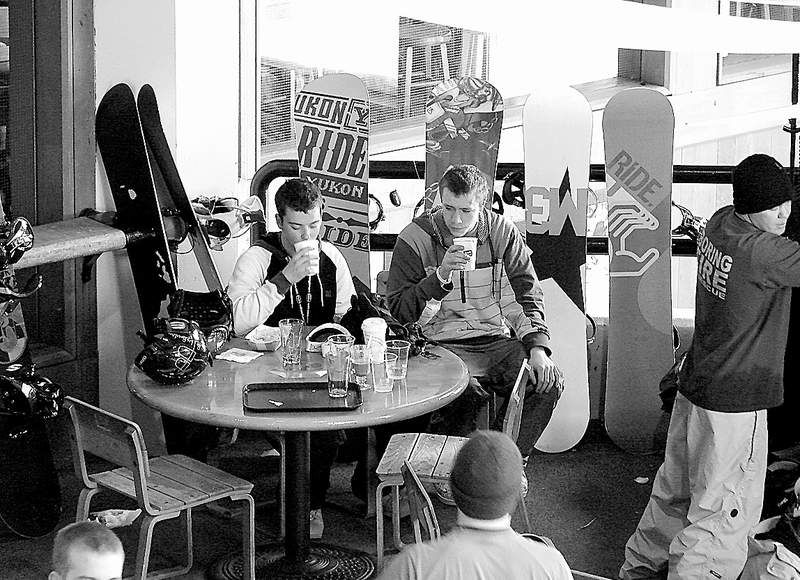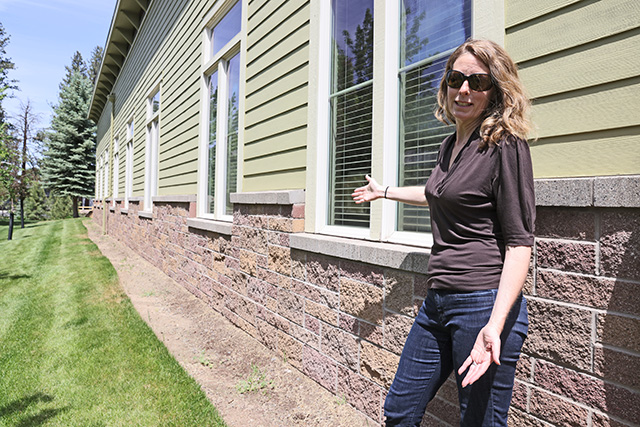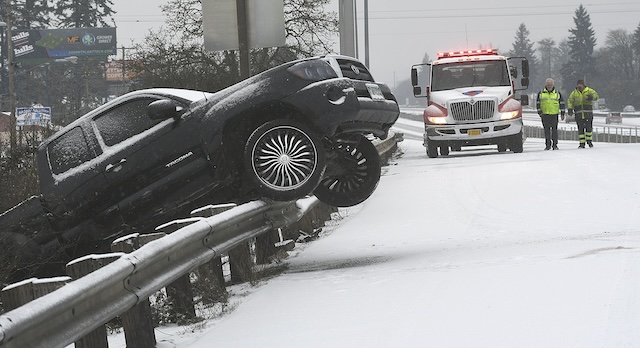‘Heeere’s Timberline!’
Published 5:00 am Sunday, March 15, 2009

- A snowplow clears the parking lot at Timberline Lodge during a winter blizzard. Future development at the hotel calls for a high-tech polycarbonate “snow cave” to replace the Quonset hut-like entrance next season.
I have a feeling that first-time visitors to Mount Hood’s Timberline Lodge expect to see Jack Nicholson wandering the corridors with an ax, sticking his head through a half-chopped door and greeting them with a cheery, “Heeere’s Johnny!”
But Nicholson has never set foot in the lodge, even though it is widely associated with his 1980 horror movie, “The Shining.”
Yes, a snowbound Timberline provided the exterior model for the film’s Overlook Hotel, but not a single acting scene was filmed there, according to Jon Tullis, Timberline’s director of public affairs and an employee since 1985.
Movie director Stanley Kubrick, seeking to capture a particular mood (author Stephen King’s 1977 novel had been inspired by a Colorado hotel), found what he was looking for in a single visit to Timberline, Tullis said. So he had a model of the lodge built at a studio in London, where the movie was filmed. Kubrick’s interiors were based on the Ahwahnee Hotel at Yosemite National Park in California. Timberline has no Gold Ballroom and no Room 237.
Nevertheless, in many minds, the ominous sense of “The Shining” is nowhere as prevalent as it is at Timberline, especially when midwinter snow drifts high against its walls. And Timberline’s management takes full advantage of the association, hosting special Halloween-night screenings and other events. In 2008, said Tullis, “Nike threw a ‘Shining’ party and took the whole place over.”
The lodge
Situated at the 6,000-foot level on the south slope of 11,245-foot Mount Hood, 60 miles east of Portland and 109 miles north of Bend off U.S. Highway 26, Timberline Lodge may be reached via a winding road from Government Camp. Even in dry, sunny weather, the switch-backing access road, which climbs 2,000 feet in just 5½ miles, is a challenge to drive; in the dimly lit winter, with howling winds blowing freshly fallen snow across an often-icy route, it can be downright treacherous.
That doesn’t stop scores of Portland-area skiers from making the ascent. Last winter, Timberline logged 285,000 skier visits. They find not only the historic 1937 lodge itself, a monument to the passion and fortitude of Depression-era laborers, but also a spacious day lodge and other facilities that make this a year-round destination for winter sports lovers.
The main entrance to Timberline Lodge is through a Quonset hut-like tunnel, an effective buffer between the cold of winter and the warmth of the lodge. (By 2010, Tullis said, it will be replaced by a high-tech “snow cave,” built with polycarbonate panels.) At the top of a slowly rising concrete stairway, double doors open to a circular lobby, its central fireplace and chimney going up through a series of common areas to restaurants and lounges.
The lodge has 70 guest rooms, ranging from a romantic two-person fireplace room with a king bed to a 10-person chalet with bunk beds. Most of them extend down three stories of corridors south of a small reception desk. The standard-size room I inspected on a recent visit was cozy and rustic, but tidy and comfortable, with a queen-size bed, full bath, closet, handmade desk and chair, television and telephone.
Any time of year, but especially in winter, guests gather around the massive fireplaces — large enough to walk into — and sip warm beverages, converse, play games, read or work on laptop computers. (A wireless Internet connection is available in the main lobby area.) Just off the ground-floor lobby are a theater for lectures and films, a game room, and a series of exhibits describing the history of the lodge and of skiing on Mount Hood.
One floor up is the Cascade Dining Room, Timberline’s fine-dining restaurant. I enjoyed a wonderful dinner here — a smoked filet mignon Oscar with asparagus and Dungeness crab — with a glass of fine Walla Walla, Wash., syrah. The upper story is home to the Ram’s Head Bar, where lighter meals are available.
Down a corridor on the ground floor is the Blue Ox Bar, open weekends and holidays, and featuring 1930s mosaic murals of mythical lumberjack Paul Bunyan and Babe, the Blue Ox. At the other end of the hotel are a sauna, an outdoor swimming pool and a hot tub, which seem to be especially popular when the temperature is frigid and snow is falling all around.
Skiing and other sports
The lodge is at the heart of the ski resort’s system of six chairlifts, which open up 3,590-vertical feet of skiing, the most in the Northwest. Three of the chairs — Molly’s Express, Pucci and the new (in 2008) Jeff Flood-Still Creek Chair — extend more than 1,000 feet below the lodge. These are lighted for Friday and Saturday night skiing through the winter season. A permanent terrain park for snowboarders flanks the Stormin’ Norman chair west of the lodge.
Timberline’s two upper lifts are its best known. The Magic Mile Super Express rises above the tree line to about 7,000 feet, accessing vast expanses of untracked powder when conditions are right. And above that, the Palmer Express chair climbs to 8,540 feet and guarantees snow from mid-June to Labor Day.
“We have some of the best spring and summer skiing in the U.S.,” Tullis said. “With the Winter Olympics coming up next year in Canada, we will have many Olympians training here this summer.”
Timberline’s regular season runs through May 25, and a March-through-May pass is already for sale, offering unlimited visits until that date for $99. A standard adult, all-day lift ticket is $52.
Skiers are served by the Wy’east Day Lodge, built in 1981 to allow ski rentals, ticket sales, ski-school and ski-patrol headquarters, and other winter-sports facilities to be moved from Timberline Lodge. The day lodge has two restaurants of its own, one with a full bar and the other with a cafeteria-style buffet line, plus an expansive gift shop.
Although, as Oregon’s highest summit, Mount Hood is snow-capped year-round, the majority of its visitors come not for the winter sports but for summer activities. Resort statistics show 1.9 million annual visits, the lion’s share between Memorial Day and Labor Day. Many of those people come merely to enjoy the view and the crisp alpine air, but others enjoy hiking or even mountain climbing.
Especially popular in summer is a ride up the Magic Mile and a one-mile hike back to Timberline Lodge. But hardier visitors may don backpacks, especially from July through September, and take two or three days to hike the 40-mile Timberline Trail that circles the mountain. Inquire ahead if you consider making this a part of your summer plans, as a section of trail on the east side of the mountain still requires a detour around landslides that occurred in late 2004.
Remembering the past
The history of Timberline dates back to the Great Depression-era of the 1930s. Beginning in June 1936, the Works Progress Administration, also known as the WPA, employed some 350 workers, most of them unskilled. Most of their materials were timbers and rock they found in the mountain wilderness. And these workers put the lodge together by hand, without the kind of industrial machinery available today.
“They were purposely put together as apprentices with skilled craftsmen,” said Tullis, who has been at Timberline for 24 years. “They got 90 cents an hour, enough to send home and some for their pocket. They had a job, three meals a day and they got to learn a trade. It was a great opportunity. And the lodge became a symbol of hope and purpose during some very tough times.”
President Franklin D. Roosevelt dedicated Timberline Lodge on Sept. 28, 1937, just 15 months after construction began. Uncertain seasonal weather — and an uncertain future for the WPA — hastened the work time. After finishing touches in the lodge interior were completed, Timberline opened to the public in February 1938.
Declared a National Historic Landmark in 1977, Timberline is considered by architectural experts to be the finest example of a regional style known as “Cascadian.” The high, cathedral-like ceiling of the lodge lobby is intended to imitate Mount Hood’s summit. The immense Douglas fir timbers were hand-hewn with axes.
Throughout the lodge are ornate finishing touches added by the artisans: animal and bird carvings, ornamental ironwork, carved linoleum, fabric and glass work, museum-quality original paintings.
The lodge fell into disrepair after World War II and was closed in the early 1950s. Richard L. Kohnstamm, a visionary New Yorker who anticipated the boom in skiing as a recreational sport, won a bid to operate the lodge in 1955 and within five years was turning a profit. Kohnstamm continued to run Timberline until 1992, when he turned over the reins of RLK and Co. to his son, Jeff, who remains in charge today. The senior Kohnstamm died in 2006 at the age of 80.
What the future holds
Already holding the longest special-use permit in the history of the U.S. Forest Service, Timberline Lodge is focusing its future development on transportation issues. Current parking facilities are regarded as insufficient. A long-range solution, according to an RLK and Co. publication, may be to build an underground garage with elevator access to the lodge.
In addition, a mountain-wide shuttle-bus system operating from a public parking area in Government Camp has widespread support, especially in light of the hoped-for passage of a new wilderness bill. One of the provisions of the bipartisan Lewis and Clark Mount Hood Wilderness bill, Tullis said, would provide funding for a multi-pronged transportation plan serving the Mount Hood area.
Now on the back burner, but far from dead, is a proposal to build a gondola between Government Camp and Timberline Lodge. According to the company report, the upper terminal would be linked both to the lodge and to the skiers’ day lodge via an underground passage.
And Nicholson never needs to know about it.








